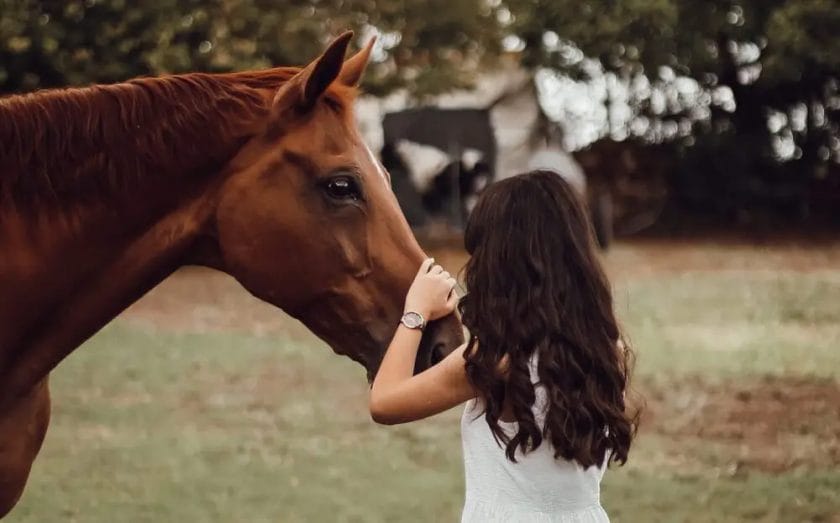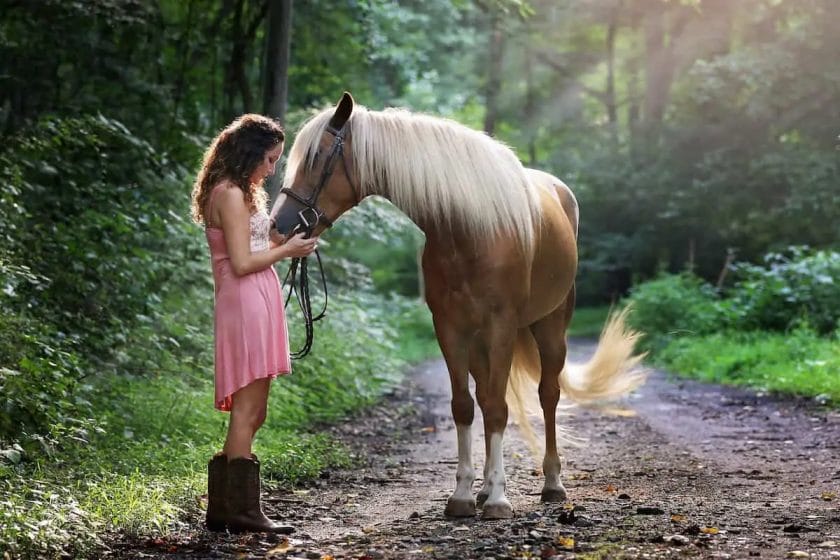Bonding with a new horse is a crucial step in developing a strong and trusting relationship. By taking the time to understand and connect with your horse, you can create a foundation of mutual respect and cooperation.
One of the best ways to bond with a new horse is through consistent and gentle handling. Spend time with your horse every day, grooming, leading, and interacting in a calm and patient manner.
Building trust is key in bonding with your horse. Take the time to listen and observe your horse’s behaviors, needs, and preferences. This will help you tailor your interactions to their individual personality and build a deeper connection.
Engaging in activities together can also strengthen the bond. Whether it’s going on trail rides, practicing groundwork, or participating in fun exercises, these shared experiences will help foster a sense of camaraderie and understanding.
Remember, bonding with a new horse takes time and patience. Don’t rush the process and allow the relationship to develop naturally. With consistent effort and a genuine desire to connect, you’ll forge a lifelong partnership with your equine companion.

Effective Communication Techniques for Connecting with Your New Horse
Bringing a new horse into your life can be an exciting and rewarding experience. However, building a strong connection and effective communication with your new equine companion is crucial for a successful relationship. In this section, we will explore some techniques that can help you connect with your new horse and establish a harmonious partnership.
1. Establish Trust and Respect
A solid foundation for effective communication starts with trust and respect. Horses are prey animals and have evolved to be highly sensitive to their surroundings. Building trust with your new horse is essential to establish a sense of security and create a positive environment for communication.
Respect is equally important, as horses are naturally hierarchical animals. Demonstrating respect through consistent boundaries and fair handling will help your horse understand their place in the partnership and strengthen the bond between you.
2. Use Clear and Consistent Body Language
Horses are incredibly perceptive to body language and rely on visual cues to understand our intentions. When communicating with your new horse, it is vital to use clear and consistent body language to avoid confusion.
Stand tall and confident, keeping your movements deliberate and purposeful. Use your posture, gestures, and eye contact to convey your intentions clearly. Maintain a calm and relaxed demeanor, as horses are highly attuned to your energy and emotions.
3. Practice Groundwork Exercises
Groundwork exercises serve as a crucial foundation for effective communication under saddle. These exercises involve working with your horse from the ground, teaching them essential cues and reinforcing respect and responsiveness.
Engage in exercises such as leading, backing up, yielding hindquarters, and yielding forequarters. These exercises help your horse become more attentive, responsive, and respectful, laying the groundwork for a successful riding partnership.
4. Use Positive Reinforcement
Positive reinforcement is a powerful tool for reinforcing desired behaviors and strengthening the bond with your new horse. Rewarding your horse for good behavior with treats, praise, or a gentle pat serves as a motivator and encourages future cooperation.
However, it is important to use positive reinforcement strategically and in moderation. Ensure that the rewards are appropriate and timely, reinforcing the behavior you desire.
5. Develop a Consistent Routine
Horses thrive on routine and predictability. Establishing a consistent daily routine helps your horse feel secure and builds trust in your communication. Feed and exercise your horse at regular times, maintain a consistent handling approach, and create a structured environment.
Consistency in routine reassures your horse and allows them to anticipate and understand your expectations, enhancing the communication between you.
6. Listen and Be Patient
Effective communication is a two-way street. While it is essential to convey your intentions clearly, it is equally important to listen to your horse and be patient with their responses.
Observe your horse’s body language and cues, as they communicate through subtle gestures and expressions. Allow your new horse time to process and respond to your requests, avoiding frustration or impatience. Patience and understanding go a long way in building a strong connection and mutual trust.
Summary
Connecting with your new horse requires time, patience, and effective communication techniques. By establishing trust and respect, using clear body language, practicing groundwork exercises, employing positive reinforcement, developing a consistent routine, and listening to your horse, you can forge a deep and meaningful connection that will enhance your partnership both on the ground and in the saddle.

Patience and Consistency: Key Ingredients for Bonding with a New Horse
Bringing a new horse into your life can be an exciting and rewarding experience. Whether you are a seasoned equestrian or a first-time owner, building a strong bond with your new horse is essential for a successful and fulfilling partnership. It requires time, effort, and most importantly, patience and consistency.
Understanding the Importance of Patience
When it comes to building a bond with a new horse, patience is the key. Horses are highly sensitive animals that thrive on trust and respect. It is important to remember that each horse is an individual with its own personality, experiences, and past training. It may take time for your new horse to feel comfortable and confident in its new environment.
By being patient, you allow your horse to adjust at its own pace. This means giving them the time and space they need to explore their new surroundings and get to know you. Rushing the process can result in stress and anxiety for your horse, which can hinder the bond you are trying to build.
The Power of Consistency
Consistency is another crucial ingredient in building a bond with your new horse. Horses are creatures of habit and thrive on routine. By establishing a consistent schedule for feeding, grooming, training, and exercise, you create a sense of security and predictability for your horse.
Consistency also extends to your interactions with your horse. It is important to be clear and consistent with your cues and expectations. This helps your horse understand what is expected of them and builds their trust in you as a reliable and consistent leader. By consistently rewarding desirable behaviors and correcting unwanted behaviors, you establish clear boundaries and reinforce positive associations.
Building Trust through Groundwork
Groundwork is an essential component of bonding with a new horse. It involves working with your horse from the ground, using various exercises to establish trust, respect, and communication. Groundwork helps you establish yourself as a leader and build a foundation of trust before progressing to riding.
During groundwork, you can work on basic commands, such as leading, stopping, turning, and backing up. These exercises not only help your horse understand and respond to your cues but also build their confidence in you as a trustworthy partner.
Consistency is particularly important during groundwork. By practicing these exercises regularly and consistently, you reinforce the bond and trust between you and your horse.
Creating Positive Experiences
It is important to create positive experiences for your horse to strengthen your bond. This can include regular grooming sessions, rewarding them with treats or praise when they perform well, and spending quality time together outside of training sessions.
Take the time to get to know your horse’s preferences and personality. Some horses may enjoy a relaxing trail ride, while others might prefer a playful session in the arena. By engaging in activities that your horse enjoys, you not only strengthen your bond but also create a positive association with you as their rider or handler.
In Summary
Building a strong bond with a new horse takes time, patience, and consistency. By giving your horse the time they need to adjust, being consistent in your interactions and training, focusing on groundwork, and creating positive experiences, you can establish a deep and meaningful connection with your new equine partner. Remember, every horse is unique, so be patient and consistent in your approach, and the bond you create will be rewarding for both of you.

Understanding Your New Horse’s Body Language to Strengthen the Bond
When you bring a new horse into your life, it’s important to build a strong bond and establish clear communication. One of the most effective ways to do this is by understanding and interpreting your horse’s body language. Horses use a variety of subtle cues and signals to express their emotions and intentions, and by learning to recognize and respond to these signals, you can deepen your connection with your new equine companion.
1. Ears
The position and movement of a horse’s ears can tell you a lot about their mood and level of attentiveness. When a horse’s ears are pricked forward, it typically indicates that they are alert and paying attention. On the other hand, if their ears are pinned back flat against their head, it may suggest that they are angry, agitated, or in pain. It’s important to pay close attention to your horse’s ears, as they can provide valuable insight into their emotional state.
2. Eyes
The eyes are often referred to as the window to the soul, and this holds true for horses as well. Horses have large, expressive eyes that can convey a wide range of emotions. When a horse has relaxed, soft eyes, it signifies a calm and content state of mind. However, wide eyes with whites showing may indicate fear, while a squinting or half-closed eye can be a sign of pain or discomfort. By observing your horse’s eyes, you can gain a deeper understanding of their emotional well-being.
3. Body Posture
A horse’s body posture speaks volumes about their mood and intentions. When a horse stands with their head held high, chest out, and tail lifted, it usually means they are feeling confident and assertive. On the other hand, a horse that is hunched, with their head lowered and tail tucked, may be expressing fear or submission. Pay attention to your horse’s overall body posture and make note of any changes, as this can help you gauge their emotional state and respond accordingly.
4. Tail and Hindquarters
The position and movement of a horse’s tail and hindquarters can also provide valuable clues about their emotions. A relaxed, loosely swaying tail typically indicates a content and relaxed horse. However, a tightly clamped tail or vigorous swishing of the tail may suggest irritation or agitation. Similarly, a horse that kicks out or lifts their hind leg is likely to be expressing discomfort or annoyance. By observing your horse’s tail and hindquarters, you can gain insight into how they are feeling in a particular situation.
5. Vocalizations
While horses are not as vocally expressive as some other animals, they do have a range of vocalizations that can convey important information. Whinnies and neighs are commonly used to communicate with other horses or signal excitement. On the other hand, squeals or snorts can be indications of aggression or alarm. Take note of your horse’s vocalizations and pay attention to the context in which they occur to better understand their intentions and emotions.
6. Overall Body Language
It’s important to remember that a horse’s body language is a combination of all these individual cues and more. By observing and interpreting their overall body language, you can gain a more comprehensive understanding of their emotions and needs. Take into account the context and environment in which your horse is displaying certain behaviors, as this can provide valuable insights into their state of mind.
Summary
Understanding your new horse’s body language is key to developing a strong bond and effective communication. By paying attention to their ears, eyes, body posture, tail, hindquarters, vocalizations, and overall body language, you can better understand their emotions, needs, and intentions. This will allow you to respond appropriately and strengthen the bond between you and your equine companion.
5. Building a Strong Foundation: Tips for Developing a Deep Connection with Your New Horse
When you bring a new horse into your life, building a strong foundation and developing a deep connection is essential. This bond will not only enhance your overall experience with your horse, but it will also improve communication and trust between you and your equine companion. Here are some tips to help you establish a deep connection with your new horse:
1. Spend Quality Time Together
One of the first steps in developing a strong bond with your horse is to spend quality time together. Dedicate regular and consistent time to just be with your horse, without any specific agenda. This could involve grooming, hand grazing, or simply sitting in their presence. The key is to create a relaxed and positive environment where you can both enjoy each other’s company.
2. Practice Groundwork Exercises
Groundwork exercises are an effective way to build trust and establish leadership with your horse. These exercises involve working with your horse from the ground, using cues to ask them to move, halt, or change direction. By practicing groundwork, you can improve communication, establish boundaries, and build a solid foundation of respect and trust.
3. Be Consistent and Clear in Your Communication
Consistency is key in developing a deep connection with your new horse. Horses thrive on routine and clear communication. Set clear expectations and be consistent in your cues and commands. Avoid confusing your horse with inconsistent signals or mixed messages. By being clear and consistent, you will build trust and strengthen your bond.
4. Understand Your Horse’s Body Language
Horses communicate through body language, and understanding their cues can help you establish a deeper connection. Take the time to learn and observe your horse’s body language, such as ear position, tail movement, and overall posture. This will enable you to better understand their emotions, needs, and preferences, and respond accordingly.
5. Offer Positive Reinforcement
Positive reinforcement is a powerful tool for building a strong connection with your horse. Rewarding desired behaviors with treats, praises, or scratches can motivate your horse and strengthen the bond between you. Remember to reward your horse immediately after they exhibit the desired behavior, so they can associate the positive reinforcement with the correct action.
6. Take Things at Your Horse’s Pace
Every horse is unique, and it’s important to respect their individual needs and boundaries. Take things at your horse’s pace and avoid rushing the bonding process. Allow your horse to gradually become comfortable with you and the new environment. Patience is key in developing a deep connection, so give your horse the time they need to trust and feel secure with you.
Summary
Building a deep connection with your new horse takes time, patience, and consistent effort. By spending quality time together, practicing groundwork exercises, being clear in your communication, understanding your horse’s body language, offering positive reinforcement, and respecting your horse’s pace, you can establish a strong foundation and develop a deep and meaningful bond. Remember, the journey of building a connection with your horse is just as important as the end result, so enjoy the process and cherish the moments shared with your equine partner.
FAQs
1. How can I bond with a new horse?
To bond with a new horse, spend quality time with them, groom them regularly, and provide consistent care. Approach them calmly and be patient, allowing them to get comfortable with you. Gradually introduce groundwork exercises and positive reinforcement training. Building trust and creating a positive association will help strengthen the bond between you and your new horse.
2. What are some tips for bonding with a new horse?
Some tips for bonding with a new horse include spending time near them, offering treats, and speaking softly to them. Take things at their pace and avoid forcing interactions. Establish a routine and be consistent in your handling. Building trust and creating a positive environment will help foster a strong bond with your new horse.
3. How long does it take to bond with a new horse?
The time it takes to bond with a new horse can vary. While some horses may bond quickly, others may take weeks or even months. Patience and consistent effort are key. Remember that every horse is different, so it’s important to build a bond at their own pace and respect their individual needs and preferences.
Conclusion
Building a strong bond with a new horse is essential for a successful partnership. By following these tips, you can create a deep connection and trust with your equine companion.
Firstly, spend quality time with your horse regularly, engaging in activities that promote bonding such as grooming, hand grazing, or simply spending time in their presence. This will help establish a sense of familiarity and comfort.
Secondly, communicate effectively with your horse through consistent and clear cues. Patience and understanding are key when teaching new skills or overcoming challenges together.
Lastly, listen to your horse’s needs and cater to their individual preferences. By providing proper care, nutrition, and a safe and comfortable environment, you will strengthen the bond and create a solid foundation of trust.
Remember, building a bond takes time, patience, and dedication. With the right approach, you and your new horse can develop a strong and lifelong partnership.
